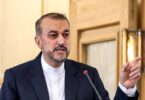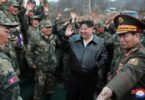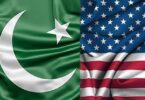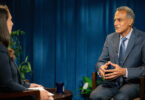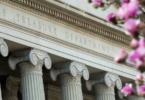TEHRAN (Reuters): Hundreds of thousands of Iranians marched and some burned U.S. flags to mark the revolution’s 40th anniversary on Monday as Iran’s leaders showed off a newly developed ballistic missile in defiance of U.S. efforts to curb their military power.
Soldiers, students, clerics and black-clad women holding small children thronged streets across Iran, many with portraits of Ayatollah Ruhollah Khomeini, the Shi’ite cleric who toppled the Shah in an Islamic uprising that still haunts the West.
On Feb 11, 1979, Iran’s army declared its neutrality, paving the way for the fall of Shah Mohammad Reza Pahlavi, the United States’ closest ally in the Middle East.
State TV showed crowds defying cold rainy weather and carrying Iranian flags while shouting “Death to Israel, Death to America,” trademark chants of the revolution which ousted the United States’ most important ally in the Middle East.
“Much to the dismay of America, the revolution has reached its 40th year,” read one banner.
After decades of hostility with the United States, Tehran said it was determined to expand its military power and ballistic missile program despite mounting pressure from hostile countries to curb its defensive work.
Iran displayed its ballistic missile capabilities during the march, including the Zolfaqar, a ground-to-ground missile with a 700 km (435 miles) range and the Qiam, with a range of 800 km, according to Tasnim news agency.
“We have not asked and will not ask for permission to develop different types of … missiles and will continue our path and our military power,” President Hassan Rouhani said in a speech at Tehran’s Azadi (Freedom) square.
Crackdown on Protests
In Washington, U.S. National Security Adviser Bolton, who in 2017 expressed the hope that Iran’s “revolution will not reach its 40th birthday”, tweeted that after 40 years the “Islamic Republic of Iran has failed to fulfill its promises to uphold and safeguard the rights of its citizens.”
The large turnout in state-sponsored rallies in which U.S. and Israeli flags were burned came as Iranians face mounting economic hardships many blame on the country’s clerical leaders.
Pictures on social media showed some demonstrators holding placards, protesting against corruption, unemployment and high prices.
“Our presence in the 40th anniversary of the revolution is to show our support for the Islamic Republic,” said one.
“But it does not mean we support corruption of some officials and their betrayal to the oppressed people.”
Reuters could not independently verify the pictures.
Last year, Iran cracked down on protests over poor living standards that posed the most serious challenge to its clerical leadership since a 2009 uprising over disputed elections.
Prices of basic foodstuffs, particularly meat, have soared since President Donald Trump withdrew Washington from the 2015 nuclear deal last year and reimposed sanctions.
In January, Rouhani said Iran was facing its worst economic crisis since the Shah was toppled. But he remained defiant, as Iranians recalled the end of a monarch who catered to the rich and unleashed secret police on dissenters.
Rouhani said U.S. efforts to isolate Iran would fail.
“We will not let America become victorious… Iranian people have and will have some economic difficulties but we will overcome the problems by helping each other,” he said.
U.S. And Israeli “Dogs”
Marchers carried cardboard cutouts of dogs. One had the face of Trump and the other the face of Israeli Prime Minister Benjamin Netanyahu.
Yadollah Javani, the Revolutionary Guards’ deputy head for political affairs, said Iran would demolish cities in Israel to the ground if the United States attacked the Islamic Republic.
“The United States does not have the courage to shoot a single bullet at us despite all its defensive and military assets,” he was quoted as saying by state news agency IRNA.
Khomeini returned from exile in France two weeks after the Shah and his wife flew to Aswan, Egypt. He was greeted by millions of supporters in Tehran. Revolutionaries later began executing supporters of the Shah including four top generals.
Khomeini died in 1989 and was followed by Iran’s current Supreme Leader Ayatollah Ali Khamenei.
Washington and the Arab world have viewed Iran with great suspicion since the Islamic Revolution, fearing Khomeini’s radical ideology would inspire militants across the Middle East.
Today, the United States and its Arab allies are trying to counter Tehran’s growing influence in the Middle East, where it has proxies in Iraq, Syria, Lebanon and Yemen.
Some Iranians criticize their leaders for what they say are foreign adventures which squander funds. Iranian leaders say they are protecting national interests.

